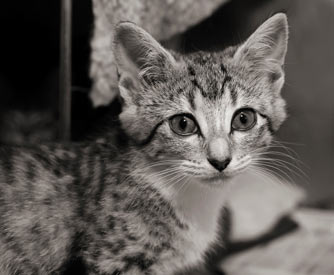Animal Cruelty: Signs and Prevention of Cruelty to Cats

Humans domesticated cats for many reasons; they used them to keep rodent levels under control, and they enjoyed the company of the sweet balls of fur, as well. Unfortunately, not everyone is kind to cats. Cruelty to cats is more common than any of us would probably like to believe. It's important to understand the different types of cruelty, the signs of an abused or neglected cat, and what you should do if you see cat abuse.
Animal Neglect
One type of cruelty to cats is neglect. This is usually a case of ignorance or financial distress on the part of the owner. Cats that do not get enough to eat, the right types of food to prevent malnutrition, or proper medical care may fall into this category.
Animal Abuse
Maliciously harming an animal with the intent to do so is called animal abuse. Here are some things to know about animal abuse:
- Children or adults with emotional problems may abuse animals.
- If the cat or other animal in a home is abused and there are children in the home, there is a high likelihood that the children are being abused as well.
- Children who harm animals are extremely likely to grow up to be violent toward other people.
Signs of Animal Cruelty in Cats
Every state has laws against animal cruelty. However, officials must know about a problem before they can act on it. They often rely on reports from observant cat-lovers for help. It's important to know how to identify the signs of neglect or abuse in cats.
It is not usually possible to tell from an animal's behavior whether she is being abused. Some cats are aggressive, fearful, or timid for reasons other than abuse. Therefore, it is necessary to look for clues in the cat's environment and on the cat herself, such as:
- Open wounds: A cat that is being abused will often have open wounds that appear to be untreated.
- Signs of multiple healed wounds: Abused cats have often suffered wounds multiple times; they may have scars or missing body parts like ears and parts of the tail. These conditions can also be due to fighting in outdoor cats.
- Untreated injury: An injury or illness may be untreated due to an owner's lack of education or finances or because the cat is being maliciously abused.
- Emaciation: extreme thinness, often with bones visible: Starvation is a common sign of animal abuse.
- Flea or tick infestation: This may be due to lack of knowledge or finances or because the animal is abused and not having basic needs attended to.
- Matted fur, overgrown nails, dirty coat: Cats that are not having their grooming needs met are being neglected and may be suffering from abuse as well. This can also happen as a cat gets older and stops grooming herself as well; the owner may not be aware that they need to start handling some grooming for an older cat.
- Weakness or inability to stand: This may indicate malnutrition or dehydration as well as injury.
- Cat is in a cage that is too small for her to be able to stand up or turn around: This could also be seen in cases of too many cats kept in the same cage.
- A person hitting, kicking, or otherwise physically harming a cat: If you see someone actively harming a cat, do not confront the person; you may at risk of injury yourself. If possible, record the incident without being observed to be doing so. If that isn't possible, observe as much as you can about the situation and call 911.
A cat that is being treated for a medical problem may appear to be unhealthy to an onlooker, especially in the cases of chronic skin conditions and lameness. Observing an animal over time can help you to determine if abuse or neglect is occurring.
Outdoor Cats
Cats that live or spend unsupervised time outdoors may be at risk of being abused by someone other than their owners. They may be caught by someone else and mistreated or abused because the cat is seen as a nuisance or because the catcher is mentally ill.
A Note on Black Cats
It is widely believed that black cats are at higher risk of abuse than other cats, especially around Halloween. Many groups, including the ASPCA, have found this to be untrue. However, black cats do find it harder to be adopted from shelters than other cats. This is more than likely due to a long history of association between black cats and bad luck. Black cats do not bring bad or good luck to owners, unless you count the good luck of having a sweet, loving, furry best friend.
What to Do If You Suspect the Neglect or Abuse of a Cat
If you see someone actively physically abusing a cat, call 911. If you suspect abuse or neglect of a cat, call your local animal control department or animal welfare agency. You can find contact information by searching google for "animal welfare" + your community name. If your area doesn't have a department for animal cruelty cases or isn't able to handle them, contact the Humane Society of the United States at
Write down the details of any incidents or conditions that you observe in association with the abuse or neglect that you are reporting, including dates, times, places, and the descriptions of any people involved.
We must all work together to protect cats from abuse and neglect.
ADDENDUM: The FBI has reclassified animal abuse as a felony. This will begin in 2016, and it means that the worst cat abuse cases will be prosecuted the same as murder, burglary, and arson. This is a great step forward in the fight against cat abuse and, by extension, domestic violence. See this link for more information: ppnnow.com/fbi-makes-animal-abuse-a-felony-in-2016/
You May Also Like These Articles:
Keep Your Cat Safe and Happy During The Holidays
Dehydration in Cats: How Can You Tell If A Cat Is Dehydrated?
Ethoxyquin, Mercury, and PCBs: Is Feeding Fish Safe for Cats?
Petting Induced Aggression in Cats
How Cats Use Their Posteriors in Friendly Body Language
Notice: Ask-a-Vet is an affiliated service for those who wish to speak with a veterinary professional about their pet's specific condition. Initially, a bot will ask questions to determine the general nature of your concern. Then, you will be transferred to a human. There is a charge for the service if you choose to connect to a veterinarian. Ask-a-Vet is not manned by the staff or owners of CatHealth.com, and the advice given should not delay or replace a visit to your veterinarian.





